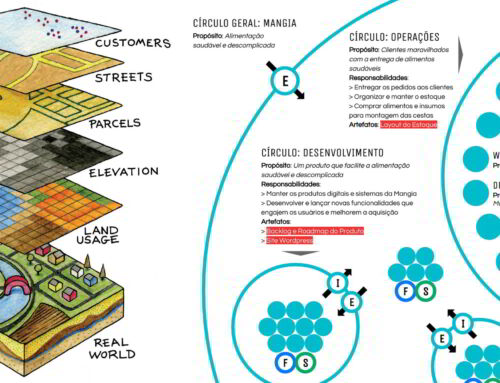It seems like a good idea: involving your entire team in most day-to-day decisions. The price of the product is not adequate to the new market situation. Let’s call everybody and decide together, right? This can be very dangerous for your organization. Understand how you can balance participation and speed in decision making.
Consensus
A decision by consensus implies that everyone in the group believes that a particular choice is the best possible for that moment. If a person disagrees or just thinks that there is a better alternative, he or she is not in consensus. This mechanism can be effective, since it produces decisions that everyone agrees with, but it’s not efficient at all because you will need hours of conversation, a facilitator, and a lot of energy to sustain the process.
There is another consensus problem that is rarely portrayed in books on the subject. If you don’t have a facilitator available all the time, inevitably the people who can best articulate their arguments, the more outgoing, and those who have some kind of institutional power (a manager, for example) will have more influence on decisions. This certainly is not an interesting result if you desire equivalence.
You mean I should not involve my team in the decisions?
If involving means getting advice and hearing, the answer is yes. But listening to what they think is different from trying to integrate all perspectives into every decision and reaching consensus. This should be avoided as it will take a lot of time and will be extremely stressful.
But I want them to participate in the decisions. How can I accomplish that without consensus?
First of all, let’s clarify the term “decision”.
Types of Decisions
Organizations that practice dynamic governance (Sociocracy, Holacracy and S3) separate work into two types: governance and operations. I will add a third category, which I will call assignments. This separation is important for determining the desirable level of participation in each type of decision.
Governance corresponds to the organizational structure: roles, accountabilities and policies (agreements) established by the groups / teams. A governance decision implies changing those elements. For example, defining a role called Pricer, which is accountable for defining the price of products is a governance decision.
Operations corresponds to all other decisions that don’t belong to governance or which are the responsibility of some role. For example, deciding what the price of a particular product is an operational decision, because it is already the accountability of the Pricer role, assuming that it has been defined.
Assignments correspond to the choice of people suitable for the defined roles in governance. This type of decision usually resides in the manager, leader, coordinator, etc. Who will play the role of Pricer? This is an assignment decision.
Now that we separated decisions in governance, operations, and assignments, we can identify what kind of participation is desirable in each case.
Getting your team involved
For governance decisions, it’s interesting not only to listen to your team, but also to consider possible concerns and integrate them. After all, the governance structure (roles, accountabilities, and agreements) greatly affect all members of your group or team. Further on will be explained how this can be done.
For assignment decisions, there are two possible paths. One is to structure a collective process of evaluating role performance. Thus anyone can propose a new (re)attribution and/or evaluate the performance of another person. Another way is for you (manager, coordinator, etc.) to decide on your own, just listening to your team, but not necessarily integrating all perspectives.
For operational decisions, you (and other people) must take them autocratically. That’s right. You can listen to advice and opinions from colleagues, but do not try to integrate them. What? ????
Maximum agility: autocratic operational decisions
Most day-to-day decisions (which are operational) are easily reversible in case of major disasters. In this condition, deciding individually is the most productive (efficient and effective) strategy. Imagine if you had to consider everyone’s opinion every time you changed a phrase on your company website! It would be extremely time consuming and painful.
In addition, individual decisions give autonomy and freedom to the person who is playing the role. He or she has room to try, to make mistakes and to learn.
Equivalence and participation: governance decisions by consent
I have mentioned that for governance decisions it is interesting to listen to and integrate the possible concerns of your team. Even so, I do not think consensus is an adequate mechanism. I believe that consent is more appropriate.
To make a decision by consent, it is necessary that someone brings a proposal for solving a particular tension (problem, opportunity). In order for this proposal to be approved, all participants in the group/team must consent to it.
Consenting doesn’t mean that it is the best solution. Consent means you have no objection to the proposal. The definition of objection varies according to the social technology you use. For Holacracy, the objection is some irreversible harm that the proposal will cause to the group and move us back. Sounds serious, right? Well, few things are really objections if you consider that definition.
Using a process based on proposals and by consent for governance decisions promotes leadership in your team. The person who brings a proposal will have all the conditions to approve it. In case of objection, it must be integrated with the proposal so that it still solves the original problem, but does not creates the objection. In Holacracy, this step by step is called an integrative decision-making process.
Remember that consent is for governance decisions. Just roles, accountabilities and agreements.
The decision-making format described above corresponds to what is practiced in most evolutionary social technologies, such as Holacracy and Sociocracy 3.0.
Using this mechanic, you will be able to eliminate all operational decision-making meetings in your group, team, or organization. With the exception of governance, all decisions can be made in an autocratic and individual way.
The effort to describe the governance structure (roles, accountabilities and agreements) generates rapid gains in efficiency and autonomy. With clear roles, people can focus on work and make good decisions. And fast.







[…] (E) Consensus is something that we escape to the maximum. We only make group decisions using an Integrative Decision Making process and even being faster than consensus, we only use it to decide on agreements, policies, assignment of responsibilities and distribution of authority. Read here to better understand how to escape consensus. […]
[…] I will not enter into the argument here about the slowness of decision-making by consensus. If you want, here’s a blogpost about it. […]
[…] So the first tip is obvious: don’t create a selection process that excludes so many differences. Of course, with great diversity comes the need for mechanisms to deal with dissent and controversy. But this is another topic. […]
[…] And this only happens when the maximum of autonomy is given and of definitive way, not of circumstantial way. This means distributing authority to teams and people. Fleeing also from analysis paralysis and slow consensus. […]
[…] (E) Consensus is something that we escape to the maximum. We only make group decisions using an Integrative Decision Making process and even being faster than consensus, we only use it to decide on agreements, policies, assignment of roles, and distribution of authority. Read here to better understand how to escape consensus. […]
[…] I will not enter into the argument here about the slowness of decision-making by consensus. If you want, here’s a blogpost about it. […]
[…] people vote? We don’t work like that and definitely don’t propose anything like that. The self-management practices we use and suggest in our workshops and consultancy work take an oppos… We believe in agile management, and encourage that many small decisions be made autonomously by […]
This “A decision by consensus implies that everyone in the group believes that a particular choice is the best possible for that moment.” is only one possible definition of consensus, and in my opinion, just about the worst one. There is another perfectly good name for that — it is “unanimity”. Personally I’m fed up with people making a straw man out of the concept of consensus and rubbishing it.